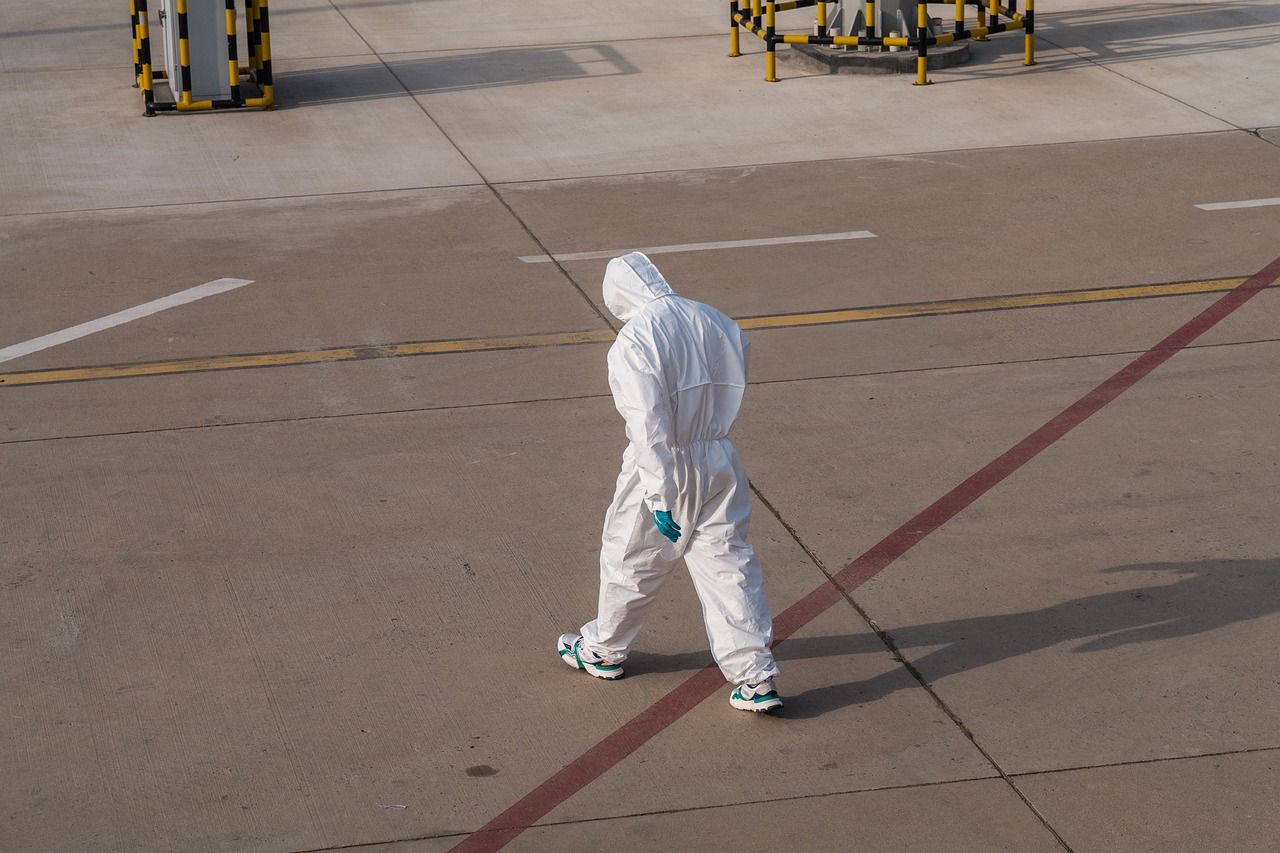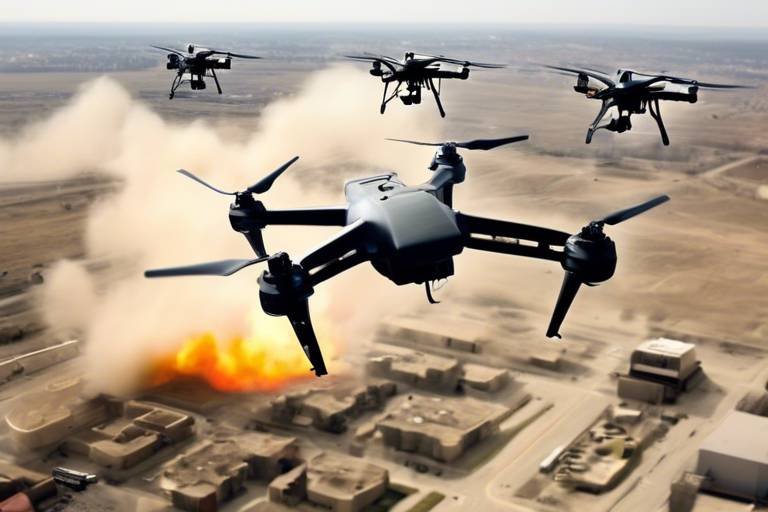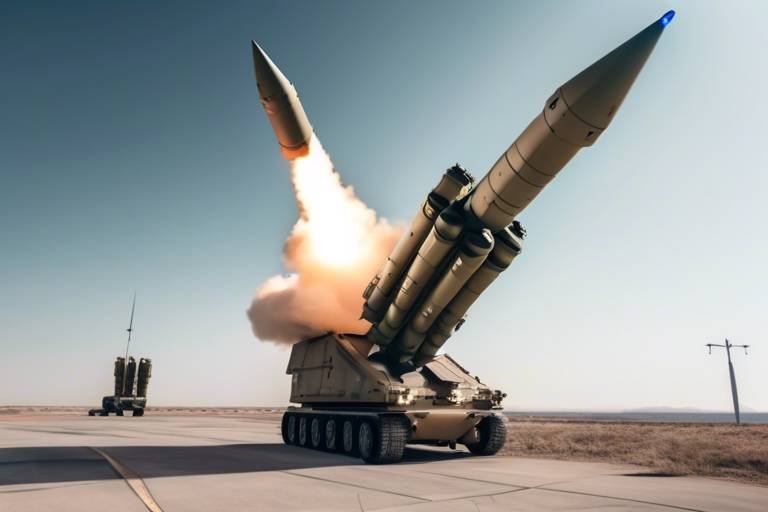Future Applications of Biometric Technologies in Defense
The landscape of defense is rapidly evolving, and at the forefront of this transformation are biometric technologies. These advanced systems are not just a passing trend; they represent a significant leap towards enhancing security, operational efficiency, and identity verification within military and defense sectors. Imagine a world where access to sensitive information and installations is strictly controlled, ensuring that only authorized personnel can enter. This is not just a dream—it's becoming a reality thanks to biometrics.
As we delve deeper into the potential advancements, it's essential to recognize how these technologies can revolutionize various aspects of defense operations. From facial recognition systems that can identify individuals in crowded environments to fingerprint recognition methods that ensure secure access to critical areas, the applications are vast and varied. The integration of these systems into existing frameworks can lead to a more secure and efficient operational environment. But what does this mean for the future of defense?
First and foremost, the use of biometric technologies in defense can significantly enhance security measures. By utilizing unique biological traits such as fingerprints, facial patterns, and iris scans, military organizations can create robust security protocols that are nearly impossible to bypass. This level of security is crucial in safeguarding military installations and protecting sensitive data from unauthorized access. Imagine a scenario where a soldier approaches a secure facility; instead of using a keycard, they simply scan their fingerprint or face. This not only speeds up the process but also drastically reduces the chances of breaches.
Moreover, the importance of identity verification cannot be overstated. In defense operations, knowing who is who can mean the difference between success and failure. Biometric systems streamline the identification process, allowing for quick and accurate verification of personnel and equipment. This is particularly advantageous in high-stakes situations where time is of the essence. For instance, during a military operation, the ability to swiftly identify allies and potential threats can save lives and enhance mission effectiveness.
As we look toward the future, the integration of biometric technologies with existing systems is a game-changer. The potential for facial recognition systems to enhance surveillance capabilities is particularly noteworthy. These systems can analyze real-time data to identify individuals in crowded environments, providing military personnel with enhanced situational awareness. Imagine a bustling market where a known suspect is present; with facial recognition technology, military operatives can swiftly identify and assess threats, leading to more informed and timely responses.
However, this technology is not without its challenges. Issues such as accuracy, privacy concerns, and potential biases must be addressed to ensure that the implementation of biometric technologies in defense is both effective and ethical. For instance, while facial recognition can enhance security, it can also lead to misidentifications, raising questions about its reliability. Therefore, a careful balance must be struck between leveraging these technologies and protecting individual rights.
Fingerprint recognition technology also plays a vital role in defense applications. It remains one of the most reliable biometric methods for secure access. Whether it's for personnel authentication or ensuring the security of sensitive equipment, fingerprints provide a level of assurance that traditional methods simply cannot match. As technology advances, we can expect fingerprint recognition systems to become even more sophisticated, further enhancing their effectiveness in various defense scenarios.
As biometric data becomes integral to defense operations, the importance of data management and security cannot be overlooked. The collection and storage of biometric information pose significant challenges, particularly regarding data protection. Best practices for managing this data are essential to prevent breaches that could have dire consequences in military contexts. For instance, implementing strict access controls and regular audits can help safeguard sensitive information from unauthorized access.
| Biometric Technology | Application in Defense | Benefits |
|---|---|---|
| Facial Recognition | Surveillance, Threat Detection | Enhanced situational awareness |
| Fingerprint Recognition | Access Control, Personnel Authentication | High reliability and security |
Additionally, employing advanced encryption techniques is crucial for protecting biometric data. Various encryption methods can safeguard sensitive information from unauthorized access, ensuring that even if data is intercepted, it remains secure. This is particularly vital in defense operations where the stakes are high, and the potential for misuse of data could lead to catastrophic outcomes.
Lastly, compliance with regulatory frameworks surrounding biometric data usage is essential. Defense organizations must navigate a complex landscape of legal requirements to ensure that they are not only protecting their operations but also respecting individual rights. By maintaining compliance, they can build trust and ensure that biometric technologies are used responsibly and ethically.
- What are biometric technologies? Biometric technologies use unique biological traits for identification and access control.
- How can facial recognition improve defense operations? It enhances surveillance and situational awareness by identifying individuals in real-time.
- What challenges do biometric technologies face? Challenges include accuracy issues, privacy concerns, and potential biases.
- Why is data management important in defense? Proper data management protects sensitive information from breaches that could compromise security.
- What is the role of encryption in biometric data security? Encryption protects biometric data from unauthorized access, ensuring its confidentiality and integrity.

Enhanced Security Measures
In today's world, the demand for heightened security measures has never been more critical, especially in the defense sector. Biometric technologies offer innovative solutions that not only enhance security but also streamline access control to sensitive areas and information. Imagine a world where every entry point to a military installation is fortified with advanced biometric systems. This isn't just a futuristic dream; it's becoming a reality. By utilizing unique biological traits—like fingerprints, facial features, and iris patterns—military organizations can ensure that only authorized personnel gain access to critical facilities and data.
Biometric systems operate on the principle that each individual is unique, making it nearly impossible for unauthorized users to bypass security measures. For instance, consider a military base equipped with state-of-the-art biometric scanners at every access point. These scanners can instantly verify a person's identity against a secure database, allowing for rapid and accurate access decisions. This not only reduces the risk of unauthorized entry but also minimizes the chances of human error that can occur with traditional security measures like ID cards or passwords.
Furthermore, the implementation of biometric technologies can significantly improve the overall security posture of defense organizations. By integrating biometrics into their security protocols, military installations can achieve:
- Real-Time Monitoring: Continuous tracking of personnel movements enhances situational awareness and enables quick responses to potential threats.
- Reduced Risk of Fraud: Biometric authentication drastically lowers the risk of identity theft, ensuring that only legitimate personnel are granted access.
- Streamlined Processes: Automated identity verification speeds up the entry process, allowing military personnel to focus on their primary duties rather than cumbersome security checks.
Moreover, the use of biometric technologies can extend beyond physical access control. In the digital realm, safeguarding sensitive information is paramount. Biometric authentication can be applied to secure computer systems and networks, ensuring that only authorized users can access classified data. This multi-layered approach to security not only protects physical assets but also fortifies digital infrastructures, creating a comprehensive security environment.
However, while the advantages of biometric technologies are compelling, it's crucial to recognize the importance of implementing these systems responsibly. As the military adopts these technologies, they must also consider the ethical implications, such as privacy concerns and the potential for misuse. Striking a balance between enhanced security and individual rights will be vital for the successful integration of biometrics in defense operations.
- What are biometric technologies? Biometric technologies are security systems that use unique biological traits, such as fingerprints or facial recognition, to identify individuals.
- How do biometric systems enhance security? They provide a reliable method of verifying identity, reducing unauthorized access and enhancing overall safety.
- Are there any privacy concerns associated with biometrics? Yes, the use of biometric data raises privacy issues, and it's important for organizations to handle this data responsibly.
- Can biometric systems be hacked? While biometric systems are generally secure, no system is completely immune to hacking. Continuous improvements and updates are necessary to maintain security.

Identity Verification
Accurate is crucial in defense operations, where the stakes are incredibly high. Imagine a scenario where a military base is compromised due to unauthorized access; the consequences could be catastrophic. Biometric systems like fingerprint and facial recognition technologies are revolutionizing how personnel and equipment are identified in various scenarios, ensuring that only those with the right credentials can enter sensitive areas or access critical information.
One of the most significant advantages of these biometric systems is their ability to streamline the identification process. Traditional methods of verification, such as ID cards or passwords, can be easily lost, stolen, or forged. In contrast, biometrics use unique physical characteristics that are nearly impossible to replicate. For instance, a fingerprint is as unique as a snowflake—no two are the same! This uniqueness provides a level of security that is essential in military contexts, where every second counts.
Furthermore, biometric systems can be integrated into various defense applications. For example, during military operations, personnel can be quickly verified using fingerprint scanners or facial recognition software, allowing for rapid response times. This is especially critical in high-pressure situations where every moment matters. The ability to instantly confirm a soldier's identity can be the difference between mission success and failure.
Moreover, the use of biometric technologies in identity verification extends beyond personnel. Equipment and vehicles can also be tagged with biometric identifiers, ensuring that only authorized users can operate them. This not only enhances security but also helps in tracking and managing military assets effectively. Imagine a scenario where a military vehicle can only be started by its designated operator, reducing the risk of theft or misuse.
To illustrate the effectiveness of biometric systems in identity verification, consider the following table that compares traditional methods with biometric technologies:
| Verification Method | Security Level | Speed of Verification | Risk of Fraud |
|---|---|---|---|
| ID Cards | Moderate | Slow | High |
| Password | Low | Moderate | Very High |
| Fingerprint Recognition | High | Very Fast | Very Low |
| Facial Recognition | High | Fast | Low |
As shown in the table, biometric technologies offer a significantly higher level of security and speed compared to traditional methods. This makes them an invaluable asset in the defense sector, where the need for swift and secure identity verification is paramount.
In conclusion, the integration of biometric systems into defense operations not only enhances security but also streamlines the identification process, making it more efficient and reliable. As these technologies continue to evolve, we can expect even greater advancements in how identity verification is conducted in military contexts.
- What are biometric technologies? Biometric technologies are systems that use unique physical characteristics, such as fingerprints or facial features, to verify identity.
- How do biometric systems improve security? They provide a higher level of security by using unique identifiers that are difficult to forge or replicate.
- Can biometric systems be hacked? While no system is entirely foolproof, biometric systems are generally more secure than traditional methods like passwords or ID cards.
- What are the challenges of using biometric technologies? Challenges include privacy concerns, potential biases in recognition algorithms, and the need for robust data protection measures.

Facial Recognition Systems
Facial recognition technology has rapidly evolved into a cornerstone of modern defense strategies. With its ability to identify individuals from a distance, it offers an innovative solution to enhance security and operational efficiency in military contexts. Imagine a bustling airport filled with thousands of travelers; the ability to pinpoint a threat among the crowd can mean the difference between safety and disaster. This technology not only aids in surveillance but also plays a crucial role in threat detection and maintaining situational awareness.
In defense operations, the application of facial recognition systems extends beyond mere identification. They are integrated into various platforms, including surveillance cameras and mobile devices, enabling real-time monitoring of high-risk areas. For instance, military installations can utilize these systems to scan for unauthorized personnel, ensuring that only those with the right clearance gain access. This proactive approach to security serves to mitigate risks before they escalate into serious incidents.
Moreover, the integration of facial recognition with existing surveillance systems can significantly enhance the monitoring capabilities of defense forces. By combining data from multiple sources, military personnel can achieve a comprehensive view of their environment, allowing them to respond swiftly and effectively to potential threats. This synergy between technology and human oversight creates a robust defense mechanism that is essential in today's complex security landscape.
However, it’s important to recognize that facial recognition technology is not without its challenges. Issues such as accuracy, privacy concerns, and potential biases are critical points of discussion among defense experts. The technology must be carefully calibrated to ensure that it does not misidentify individuals, which could lead to wrongful detentions or violations of privacy rights. In crowded environments, where the margin for error is slim, these concerns become even more pronounced.
As the military continues to adopt facial recognition systems, addressing these challenges will be vital. It is crucial to implement rigorous testing and validation processes to enhance the accuracy of these systems. Furthermore, establishing clear guidelines for the ethical use of this technology can help mitigate privacy concerns while still reaping its benefits. The balance between security and individual rights will be a defining factor in the future of facial recognition in defense.
- What is facial recognition technology? Facial recognition technology is a biometric system that identifies individuals by analyzing their facial features and comparing them to a database of known faces.
- How is facial recognition used in defense? In defense, facial recognition is used for surveillance, threat detection, and identifying individuals in crowded or sensitive areas to enhance security.
- What are the main challenges of facial recognition systems? Key challenges include accuracy, privacy concerns, and potential biases that can lead to wrongful identification or ethical dilemmas.
- How can privacy concerns be addressed? Implementing strict guidelines and regulations, along with rigorous testing, can help address privacy concerns while utilizing facial recognition technology effectively.

Integration with Surveillance Systems
Integrating facial recognition technology with existing surveillance systems is like adding a turbocharger to a car; it significantly enhances performance and efficiency. This integration allows for a seamless flow of information, enabling military personnel to monitor vast areas with greater precision. Imagine walking through a crowded base or a bustling urban environment where every face is a potential threat. With advanced facial recognition capabilities, the system can instantly identify individuals, flagging those who pose a risk while allowing authorized personnel to move freely.
In practice, this integration works by linking facial recognition algorithms with video feeds from surveillance cameras. When a face is captured on camera, the system analyzes it in real-time against a database of known individuals. If a match is found, alerts can be generated, prompting immediate action from security personnel. This swift identification process not only enhances situational awareness but also significantly reduces response times during critical incidents.
Moreover, the benefits of this integration extend beyond mere identification. It allows for the collection of valuable data over time, enabling defense organizations to analyze patterns and trends in behavior. For instance, if certain individuals frequently appear in restricted areas, this could indicate a potential security breach or a need for further investigation. The ability to monitor and assess these patterns provides a strategic advantage in anticipating and mitigating threats.
However, while the integration of facial recognition and surveillance systems offers remarkable advantages, it is essential to address some challenges that come along with it. Concerns about privacy, data accuracy, and potential biases in recognition algorithms must be taken seriously. Ensuring that these systems are transparent and fair is crucial for maintaining public trust and operational integrity. Defense organizations must implement robust protocols to address these issues, ensuring that the technology is used ethically and responsibly.
In summary, the integration of facial recognition technology with surveillance systems represents a significant leap forward in defense capabilities. It enhances security measures, streamlines identification processes, and provides actionable intelligence in real-time. As this technology continues to evolve, its application in military contexts will likely become even more sophisticated, paving the way for a safer and more secure operational environment.
- What is facial recognition technology? Facial recognition technology is a biometric system that identifies or verifies a person by analyzing their facial features from images or video.
- How does integration with surveillance systems work? Integration allows facial recognition algorithms to process video feeds in real-time, identifying individuals and alerting security personnel if a match with a database is found.
- What are the benefits of using facial recognition in defense? The benefits include enhanced situational awareness, quicker response times, and improved data collection for analyzing security patterns.
- What challenges does facial recognition technology face? Challenges include privacy concerns, data accuracy issues, and potential biases in recognition algorithms.

Challenges and Limitations
While the potential of biometric technologies in defense is undeniably exciting, there are several that must be carefully considered. One major concern is the accuracy of biometric systems. For instance, facial recognition technology can sometimes struggle in low-light conditions or when individuals wear masks or glasses, which may lead to false positives or false negatives. This can pose significant risks in high-stakes environments where misidentification could have dire consequences.
Another critical issue is privacy concerns. The use of biometric data raises ethical questions regarding individual rights and the potential for surveillance overreach. In military contexts, where personnel are often under constant watch, the fine line between security and invasion of privacy can become blurred. This raises the question: how do we balance the need for security with the rights of individuals?
Moreover, there are inherent biases in biometric systems that can lead to discriminatory practices. Studies have shown that some facial recognition algorithms perform less accurately for individuals with darker skin tones, women, and other marginalized groups. This can result in a disproportionate number of misidentifications, which is particularly concerning in defense scenarios where trust and reliability are paramount.
To illustrate these challenges, consider the following table that summarizes the main issues associated with biometric technologies in defense:
| Challenge | Description |
|---|---|
| Accuracy | Potential for false positives and negatives in identification. |
| Privacy Concerns | Ethical implications of surveillance and individual rights. |
| Bias | Discriminatory outcomes based on race, gender, or other factors. |
In addition to these challenges, the integration of biometric systems with existing technologies can also be problematic. Many defense organizations rely on legacy systems that may not be compatible with newer biometric technologies, leading to increased costs and implementation delays. Furthermore, the training required for personnel to effectively use these systems can be extensive, requiring time and resources that may not be readily available.
Finally, there’s the issue of data security. As biometric data is highly sensitive, any breaches can have catastrophic implications. Defense organizations must ensure that robust security measures are in place to protect this information from cyber threats, which are becoming increasingly sophisticated. The question remains: how can we safeguard this data while still leveraging its benefits for enhanced security?
In conclusion, while biometric technologies hold great promise for the future of defense, it is crucial to address these challenges and limitations head-on. By doing so, we can better harness the power of biometrics to create a safer and more secure environment for military operations.
- What are the main challenges faced by biometric technologies in defense? The primary challenges include accuracy issues, privacy concerns, biases in algorithms, integration with legacy systems, and data security risks.
- How can privacy concerns be addressed when using biometric data? Establishing clear guidelines and regulations for data usage, along with transparency about surveillance practices, can help mitigate privacy concerns.
- What measures can be taken to improve the accuracy of biometric systems? Regular updates and training for biometric systems, as well as the use of diverse datasets for algorithm development, can enhance accuracy.
- Why is data security crucial for biometric technologies? Biometric data is highly sensitive, and breaches can lead to severe consequences, including identity theft and unauthorized access to secure areas.

Fingerprint Recognition Technology
Fingerprint recognition technology has long been a cornerstone of biometric systems, offering a reliable method for secure access in various applications, particularly within the defense sector. This technology operates on the principle that each individual's fingerprint is unique, making it an effective tool for identity verification. In military operations, where security is paramount, fingerprint recognition serves as a robust solution to prevent unauthorized access to sensitive areas and classified information.
The effectiveness of fingerprint recognition lies in its ability to quickly and accurately authenticate personnel. Imagine a scenario where military personnel need to access a secure facility; instead of fumbling with keycards or remembering complex passwords, they can simply place their finger on a scanner. This not only speeds up the process but also significantly reduces the risk of human error. Moreover, the integration of fingerprint scanners with existing security systems enhances overall operational efficiency, allowing for seamless transitions between different security protocols.
One of the key advantages of fingerprint recognition technology is its versatility. It can be employed in various defense applications, including:
- Personnel Authentication: Ensuring that only authorized individuals can access restricted areas.
- Equipment Security: Protecting sensitive military equipment from unauthorized usage.
- Field Operations: Verifying identities in the field, especially in high-stakes situations where time is of the essence.
However, while the benefits of fingerprint recognition are substantial, it is essential to acknowledge the challenges associated with this technology. For instance, the effectiveness of fingerprint scanners can be influenced by environmental factors such as dirt, moisture, or extreme temperatures. These conditions can result in false rejections, where authorized personnel are denied access due to scanner inaccuracies. Furthermore, the potential for fingerprint spoofing—where an unauthorized user attempts to gain access using a fake fingerprint—poses another security concern that defense organizations must address.
To mitigate these risks, advancements in fingerprint recognition technology are continuously being developed. Innovations such as multi-modal biometric systems, which combine fingerprint recognition with other biometric methods (like facial recognition), are gaining traction. This integrated approach not only enhances security but also improves the accuracy and reliability of identity verification processes.
In conclusion, fingerprint recognition technology remains a vital component of security measures within the defense sector. Its ability to provide quick, reliable, and secure access to sensitive areas makes it indispensable. As technology continues to evolve, the integration of advanced systems will further bolster the effectiveness of fingerprint recognition, ensuring that military and defense operations remain secure and efficient.
- What is fingerprint recognition technology?
Fingerprint recognition technology uses unique patterns of an individual's fingerprint to verify their identity. - How does fingerprint recognition work?
It captures an image of a fingerprint and compares it to stored fingerprint data to authenticate an individual. - What are the advantages of using fingerprint recognition in defense?
It provides quick access, reduces human error, and enhances security by ensuring only authorized personnel can enter secure areas. - Are there any challenges associated with fingerprint recognition technology?
Yes, challenges include environmental factors affecting scanner accuracy and the potential for fingerprint spoofing. - How can these challenges be addressed?
By implementing multi-modal biometric systems and continuously improving scanner technology to enhance reliability.

Data Management and Security
As biometric data becomes integral to defense operations, the importance of managing and securing this information cannot be overstated. Just like a fortress needs strong walls to protect its treasures, defense organizations must implement robust systems to safeguard sensitive biometric data from unauthorized access and potential breaches. The implications of mishandling such data can be dire, affecting not only operational efficiency but also national security.
In the realm of defense, biometric data can include fingerprints, facial recognition data, and even iris scans. These pieces of information are invaluable for identity verification and access control. However, with great power comes great responsibility. Organizations must adopt best practices to ensure that this data is not only collected securely but also stored and transmitted safely. This involves implementing stringent data management protocols that prioritize both security and accessibility.
To effectively manage biometric data, defense organizations should consider the following best practices:
- Data Encryption: Encrypting biometric data during transmission and storage is crucial. Advanced encryption techniques can ensure that even if data is intercepted, it remains unreadable to unauthorized users.
- Access Control: Limiting access to biometric data to only authorized personnel reduces the risk of internal breaches. Implementing role-based access controls can help in this regard.
- Regular Audits: Conducting regular audits of data access and usage can help identify potential vulnerabilities and ensure compliance with established protocols.
Moreover, the implications of data breaches in military contexts can be catastrophic. Imagine a scenario where sensitive biometric data falls into the wrong hands—this could lead to impersonation, unauthorized access to secure areas, and even compromise ongoing operations. Therefore, it’s not just about having systems in place; it’s about continually evolving those systems to stay ahead of threats.
One of the significant challenges in managing biometric data is ensuring compliance with various data protection regulations. Different countries have different laws governing the use of biometric data, and defense organizations must navigate these legal frameworks carefully. This includes understanding the responsibilities associated with data collection, storage, and processing. Failure to comply can result in severe penalties and damage to an organization's reputation.
In conclusion, as we embrace the future of biometric technologies in defense, the significance of cannot be overlooked. It is the bedrock upon which successful biometric implementations are built. By prioritizing robust security measures and adhering to regulatory frameworks, defense organizations can harness the full potential of biometric technologies while safeguarding sensitive information.
- What is biometric data? Biometric data refers to unique physical characteristics, such as fingerprints, facial features, and iris patterns, used for identification and access control.
- Why is data management important in defense? Proper data management ensures the security and integrity of sensitive information, preventing unauthorized access and potential breaches that could jeopardize national security.
- What are the best practices for securing biometric data? Best practices include data encryption, access control, regular audits, and compliance with data protection regulations.

Encryption Techniques
This article explores the potential advancements and applications of biometric technologies in defense, highlighting their importance in enhancing security, identification, and operational efficiency in military and defense sectors.
Biometric technologies provide advanced security solutions, ensuring that only authorized personnel gain access to sensitive areas and information. This section discusses the role of biometrics in safeguarding military installations and critical data.
Accurate identity verification is crucial in defense operations. This subheading examines how biometric systems, such as fingerprint and facial recognition, can streamline the identification process of personnel and equipment in various scenarios.
Facial recognition technology is becoming increasingly vital in defense. This subheading explores its applications in surveillance, threat detection, and identifying individuals in crowded environments, enhancing situational awareness for military personnel.
Integrating facial recognition with existing surveillance systems can significantly improve monitoring capabilities. This section discusses how this integration can lead to more effective threat identification and response strategies in defense operations.
Despite its advantages, facial recognition technology faces challenges such as accuracy, privacy concerns, and potential biases. This subheading addresses these limitations and their implications for defense applications.
Fingerprint recognition remains a reliable biometric method for secure access. This section discusses its effectiveness in various defense applications, including personnel authentication and equipment security.
As biometric data becomes integral to defense operations, managing and securing this information is paramount. This subheading examines best practices for data protection and the implications of data breaches in military contexts.
In the realm of defense, the safeguarding of biometric data is not just a necessity; it is a fundamental principle that underpins operational integrity. serve as the fortress protecting this sensitive information from unauthorized access. By converting data into a coded format, encryption ensures that even if data is intercepted, it remains unreadable without the appropriate decryption key.
There are various encryption methods employed in defense, each with its unique strengths and weaknesses. For instance, Advanced Encryption Standard (AES) is widely regarded as one of the most secure encryption algorithms available today. It uses symmetric key encryption, meaning the same key is used for both encryption and decryption. This method is particularly effective for encrypting large amounts of data, such as biometric records.
Another commonly used technique is Public Key Infrastructure (PKI), which employs a pair of keys: a public key for encryption and a private key for decryption. This method enhances security by ensuring that sensitive information can only be decrypted by the intended recipient. Furthermore, it allows for secure communications between different defense entities, fostering a collaborative environment while maintaining strict data confidentiality.
However, the effectiveness of these encryption techniques hinges on a few critical factors:
- Key Management: Properly managing encryption keys is crucial. If keys are lost or compromised, the entire encryption process becomes futile.
- Regular Updates: As technology evolves, so do the methods employed by cybercriminals. Regularly updating encryption algorithms is essential to stay ahead of potential threats.
- Compliance with Standards: Adhering to established encryption standards ensures that defense organizations maintain a high level of security and trustworthiness.
In conclusion, the implementation of robust encryption techniques is indispensable in the defense sector. By ensuring the confidentiality and integrity of biometric data, defense organizations can mitigate risks associated with data breaches and maintain operational effectiveness.
- What is biometric data? Biometric data refers to unique physical characteristics, such as fingerprints, facial features, and iris patterns, used for identification and authentication purposes.
- How does encryption protect biometric data? Encryption transforms biometric data into a coded format, making it unreadable without the correct decryption key, thus protecting it from unauthorized access.
- What are the challenges of using biometric technologies in defense? Challenges include privacy concerns, potential biases in recognition systems, and the need for robust data management practices.
- Why is key management important in encryption? Key management is critical because if encryption keys are lost or compromised, it can lead to unauthorized access to sensitive data.

Regulatory Compliance
In the realm of defense, is not just a checkbox to tick off; it is a vital aspect that ensures the integrity and security of biometric data. As biometric technologies become more integrated into military operations, understanding the legal frameworks that govern their use is crucial. This compliance encompasses various regulations that protect individuals' privacy while allowing defense organizations to leverage these technologies effectively.
One of the primary regulations influencing biometric data usage is the General Data Protection Regulation (GDPR), which applies to any organization handling personal data of EU citizens. Under GDPR, biometric data is classified as sensitive personal data, which means that strict guidelines must be adhered to when collecting, processing, and storing this information. Failure to comply can result in hefty fines and damage to an organization’s reputation.
In addition to GDPR, defense organizations must also consider local regulations and standards that may vary by country. For instance, in the United States, the Health Insurance Portability and Accountability Act (HIPAA) and the Federal Information Security Management Act (FISMA) impose specific requirements on how sensitive data, including biometric information, is handled. Each of these laws aims to safeguard personal information while ensuring that organizations can still utilize biometric technologies to enhance security and operational efficiency.
Moreover, compliance is not a one-time effort. It requires ongoing training and awareness within the organization. Personnel must be educated about the importance of data protection and the specific regulations that apply to their work. This could involve regular workshops or training sessions focusing on the legal implications of mishandling biometric data and the best practices for maintaining compliance.
To illustrate the compliance landscape, consider the following table that outlines key regulations affecting biometric data in defense:
| Regulation | Region | Key Focus |
|---|---|---|
| GDPR | European Union | Protection of personal data and privacy |
| HIPAA | United States | Protection of health information |
| FISMA | United States | Information security for federal agencies |
In conclusion, ensuring regulatory compliance in the use of biometric technologies is essential for maintaining trust and security within defense operations. Organizations must stay informed about the evolving legal landscape and implement robust compliance programs to protect both their personnel and the sensitive data they handle.
- What is regulatory compliance in biometric technology?
Regulatory compliance in biometric technology refers to adhering to laws and regulations that govern the collection, processing, and storage of biometric data to protect individuals' privacy and ensure data security. - Why is regulatory compliance important in defense?
It is crucial because it safeguards sensitive information, maintains operational integrity, and protects the organization from legal repercussions and reputational damage. - How can organizations ensure compliance?
Organizations can ensure compliance by staying updated on relevant regulations, providing ongoing training for personnel, and implementing data protection best practices.
Frequently Asked Questions
- What are biometric technologies in defense?
Biometric technologies refer to the methods used to identify individuals based on unique biological traits, such as fingerprints, facial features, and iris patterns. In defense, these technologies enhance security by ensuring that only authorized personnel can access sensitive areas and information.
- How does facial recognition enhance security in military operations?
Facial recognition technology plays a crucial role in surveillance and threat detection. By identifying individuals in real-time, it allows military personnel to monitor crowded environments effectively, enhancing situational awareness and enabling quicker response to potential threats.
- What challenges are associated with biometric technologies?
While biometric technologies offer significant advantages, they also face challenges such as accuracy issues, privacy concerns, and potential biases in recognition algorithms. Addressing these limitations is essential for their effective application in defense contexts.
- How is biometric data managed and secured?
Managing and securing biometric data involves implementing best practices such as encryption techniques and strict access controls. These measures ensure that sensitive information is protected from unauthorized access and breaches.
- What encryption techniques are used to protect biometric data?
Advanced encryption techniques, including symmetric and asymmetric encryption, are employed to safeguard biometric data. These methods help secure sensitive information by making it unreadable to unauthorized users, ensuring data integrity and confidentiality.
- Are there regulations governing the use of biometric data in defense?
Yes, there are legal frameworks and regulations that govern the use of biometric data in defense operations. Compliance with these regulations is vital to protect individuals' privacy and ensure that defense organizations handle biometric information responsibly.



















